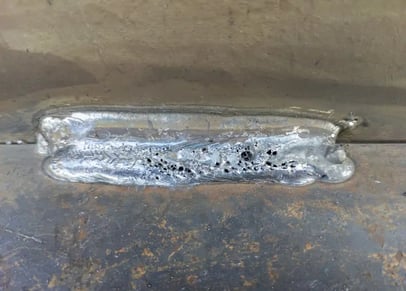Porosity in Welding: Identifying Common Issues and Implementing Finest Practices for Prevention
Porosity in welding is a pervasive concern that commonly goes unnoticed up until it creates considerable troubles with the stability of welds. In this conversation, we will discover the vital aspects adding to porosity formation, analyze its harmful results on weld performance, and discuss the finest techniques that can be adopted to lessen porosity event in welding processes.
Usual Reasons For Porosity

One more regular perpetrator behind porosity is the visibility of impurities externally of the base steel, such as oil, oil, or corrosion. When these impurities are not successfully eliminated prior to welding, they can vaporize and become caught in the weld, causing issues. Using dirty or damp filler products can present contaminations right into the weld, contributing to porosity issues. To mitigate these usual sources of porosity, complete cleansing of base metals, proper securing gas choice, and adherence to ideal welding parameters are essential techniques in accomplishing premium, porosity-free welds.
Effect of Porosity on Weld Quality

The presence of porosity in welding can dramatically jeopardize the architectural stability and mechanical residential or commercial properties of bonded joints. Porosity produces gaps within the weld metal, damaging its overall toughness and load-bearing capacity. These spaces act as anxiety focus points, making the weld extra vulnerable to fracturing and failure under used lots. Additionally, porosity can minimize the weld's resistance to corrosion and other ecological factors, additionally lessening its longevity and efficiency.
Welds with high porosity levels have a tendency to display lower impact strength and reduced ability to flaw plastically prior to fracturing. Porosity can hamper the weld's capacity to successfully transfer forces, leading to early weld failing and prospective security hazards in critical frameworks.
Ideal Practices for Porosity Prevention
To enhance the architectural integrity and top quality of welded joints, what details measures can be carried out to lessen the event of porosity during the welding process? Using the proper welding method for the particular material being welded, such as adjusting the welding angle and gun placement, can better protect against porosity. Routine inspection of welds and instant remediation of any type of concerns determined throughout the welding process are important practices to protect against porosity and generate top notch welds.
Value of Correct Welding Techniques
Executing appropriate welding methods is critical in guaranteeing the structural stability and quality of welded joints, building on the foundation of reliable porosity prevention measures. Welding strategies directly affect the total strength and sturdiness of the bonded framework. One key element of proper welding strategies is preserving the correct warm input. Excessive warmth can result in increased porosity because of the entrapment of gases link in the weld pool. Conversely, insufficient warmth may result in insufficient combination, developing possible weak factors in the joint. In addition, using the appropriate welding parameters, such as voltage, current, and travel speed, is crucial for attaining sound welds with minimal porosity.
Furthermore, the option of welding procedure, whether it be MIG, TIG, or stick welding, ought to straighten with the specific needs of the job to guarantee optimal outcomes. Appropriate cleaning and prep work of the base steel, as well as picking the her explanation ideal filler product, are likewise important components of skillful welding strategies. By adhering to these best practices, welders can reduce the danger of porosity formation and produce high-quality, structurally audio welds.

Examining and Quality Assurance Procedures
Examining treatments are crucial to identify and prevent porosity in welding, ensuring the strength and durability of the final item. Non-destructive testing techniques such look here as ultrasonic testing, radiographic testing, and visual examination are generally used to recognize prospective problems like porosity.
Post-weld assessments, on the various other hand, analyze the last weld for any kind of flaws, consisting of porosity, and verify that it satisfies defined criteria. Implementing a comprehensive quality control plan that includes thorough screening treatments and inspections is extremely important to reducing porosity problems and guaranteeing the overall top quality of bonded joints.
Verdict
In conclusion, porosity in welding can be a typical problem that influences the quality of welds. By identifying the usual root causes of porosity and implementing best methods for prevention, such as appropriate welding strategies and testing actions, welders can make sure high quality and trusted welds. It is important to prioritize prevention methods to reduce the incident of porosity and preserve the stability of welded structures.